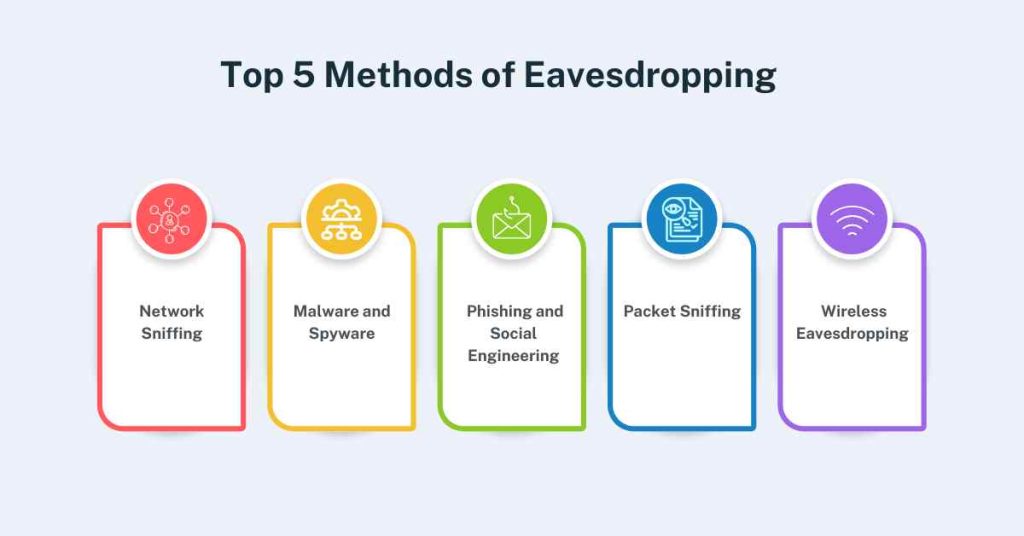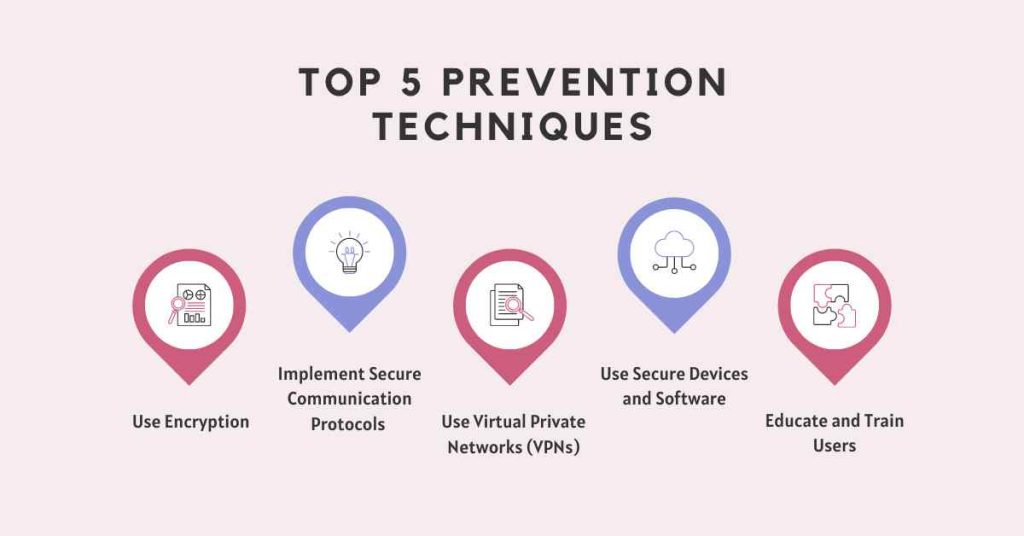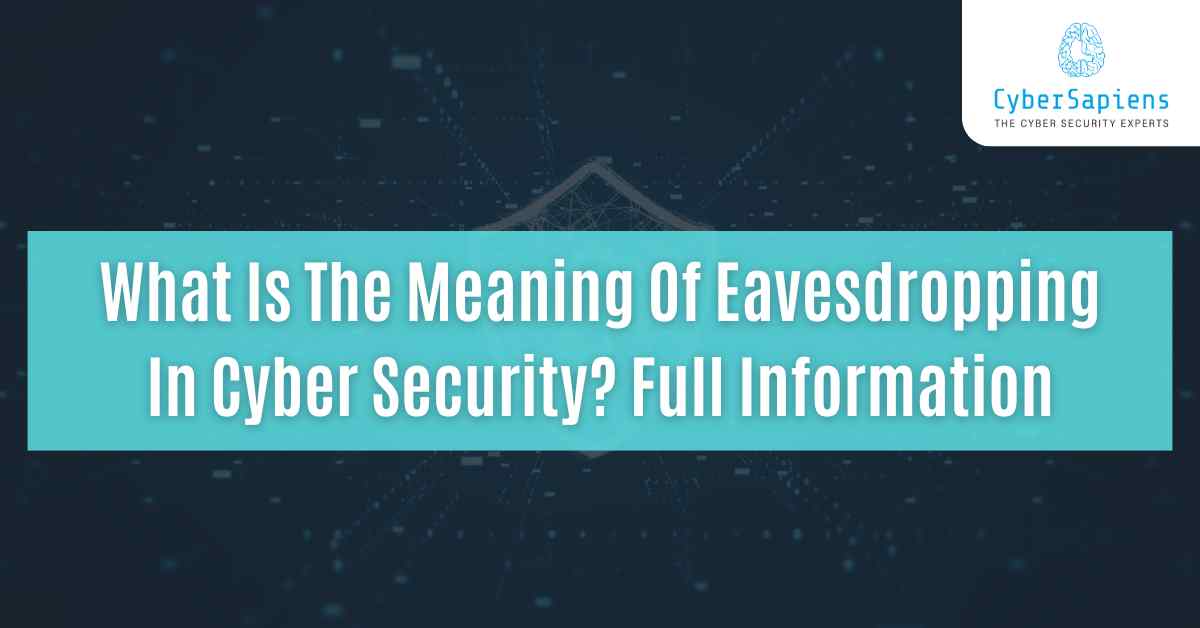In the realm of cyber security, the concept of eavesdropping refers to the unauthorized interception, monitoring, or recording of communication or data transmission between two or more parties.
This malicious activity involves a third-party individual or organization illicitly accessing sensitive information, often for exploitative purposes.
Eavesdropping can occur in various forms, including digital, analog, and even offline methods.
In this article, we will delve into What Is The Meaning Of Eavesdropping In Cyber Security?, its types, methods, prevention techniques, and the potential consequences of falling victim to such attacks.
What is Eavesdropping?
Eavesdropping is the process of intercepting and monitoring private conversations or data transmissions without the knowledge or consent of the parties involved. This unauthorized access can occur in various settings
3 Types of Eavesdropping in Cyber Security

Several types of eavesdropping can occur in cyber security, including:
1. Passive Eavesdropping
Here, the attacker acts only as a receiver of the message and does not interfere in any manner with the communicating or the data transmitting parties.
2. Active Eavesdropping
In this kind of eavesdropping, the attacker does not just listen and or capture the communiqué or data transmission but also gets an opportunity to intervene and alter or even engage the communicating or transmitting parties.
3. Man-in-the-Middle (MitM) Attack
Specifically in a Man-In-The-Middle attack, the attacker will intercept a stream/flow of communication or data transmission and then may change or add some other information to it before passing it on to the rightful recipient.
Top 5 Methods of Eavesdropping

Eavesdropping can be carried out using various methods, including:
1. Network Sniffing
Network sniffing is the ability to use programs and hardware to capture packets that are transmitted by the nodes within the network.
2. Malware and Spyware
Malware and spyware can be used to record and send such information as login, credit card details and other personal details.
3. Phishing and Social Engineering
Phishing and social engineering attacks are designed to deceive users into releasing some kind of information on the phantom threat, as well as account credentials or financial data among other details.
4. Packet Sniffing
Packet sniffing means the capture and analysis of data packets in a computer network.
5. Wireless Eavesdropping
Wireless eavesdropping is an attack whereby an attacker listens to the information being transmitted over wireless channels such as Wi-Fi and Bluetooth.
Top 5 Prevention Techniques against Eavesdropping

To prevent eavesdropping attacks, individuals and organizations can implement the following measures:
1. Use Encryption
Secure processing of information entails the protection of the data in transmission and communication against unauthorized access.
2. Implement Secure Communication Protocols
The use of secure forms of passing information which includes; https and sftp can help avert eavesdropping.
3. Use Virtual Private Networks (VPNs)
VPNs assist in making a connection encrypted from the traffic, thus making it harder for the attackers to get a hold of.
4. Use Secure Devices and Software
It suggested the university regularly update its software, including virus protection programs and firewalls, as well as secure computers.
5. Educate and Train Users
To avoid such attacks across the world educating and training the users on cyber security measures to be taken in the event like eavesdropping should be carried out.
Top 5 Consequences of Eavesdropping

The consequences of eavesdropping can be severe and far-reaching, including:
1. Financial Loss
Potential losses that can be experienced as a result of eavesdropping include; theft of identity and unauthorized transactions.
2. Reputation Damage
Interception of calls can compromise someone’s character or organization, social and trustworthiness.
3. Intellectual Property Thef
Electronic listening can cause intrusion of entity rights such as trade secrets as well as infringement on copyrights.
4. Data Breach
Eavesdropping also exposes an organization to risks of data leakage, such as the disclosure of data by an unauthorized person.
5. Liability
The eavesdropping may lead to legal consequences, which are fines and penalties for organisations’ failure to adhere to various measures on cyber security.
Conclusion
Eavesdropping is a serious cyber security threat that can occur in various forms, including digital, analog, and offline methods. Understanding the concept of eavesdropping, its types, methods, and prevention techniques can help individuals and organizations protect themselves against such attacks.
By implementing secure communication protocols, using encryption, and educating users on cybersecurity best practices, we can reduce the risk of eavesdropping and mitigate its consequences.
FAQs: What Is The Meaning Of Eavesdropping In Cyber Security?
1. What is eavesdropping in cyber security?
Ans: Eavesdropping in cyber security refers to the unauthorized interception, monitoring, or recording of communication or data transmission between two or more parties. This malicious activity involves a third-party individual or organization illicitly accessing sensitive information, often for exploitative purposes.
2. What are the different types of eavesdropping?
Ans: There are three main types of eavesdropping: passive eavesdropping, active eavesdropping, and man-in-the-middle (MitM) attacks. Passive eavesdropping involves intercepting and monitoring communication without making any changes, while active eavesdropping involves making changes or interacting with the parties involved. MitM attacks involve intercepting and altering information before forwarding it to the intended recipient.
3. How does eavesdropping occur?
Ans: Eavesdropping can occur through various methods, including network sniffing, malware and spyware, phishing and social engineering, packet sniffing, and wireless eavesdropping. These methods allow attackers to intercept and monitor sensitive information, including login credentials, financial information, and personal data.
4. What are the consequences of eavesdropping?
Ans: The consequences of eavesdropping can be severe and far-reaching, including financial loss, reputation damage, intellectual property theft, data breach, and liability. Eavesdropping can lead to unauthorized transactions, identity theft, and loss of trust and credibility.
5. How can I prevent eavesdropping?
Ans: To prevent eavesdropping, individuals and organizations can implement secure communication protocols, use encryption, and educate users on cyber security best practices. Using virtual private networks (VPNs), securing devices and software, and implementing anti-virus software and firewalls can also help prevent eavesdropping.
6. What is the difference between eavesdropping and wiretapping?
Ans: Eavesdropping and wiretapping are often used interchangeably, but they have distinct meanings. Eavesdropping refers to the interception of any form of communication while wiretapping specifically refers to the interception of telephone communications.
7. Can eavesdropping occur offline?
Ans: Yes, eavesdropping can occur offline. Offline eavesdropping involves intercepting or monitoring conversations or activities in private or public settings. This can occur through hidden microphones, cameras, or other surveillance devices.
8. How can I detect eavesdropping?
Ans: Detecting eavesdropping can be challenging, but there are signs that may indicate eavesdropping is occurring. These signs include unusual network activity, suspicious pop-ups or messages, and unexplained changes to system settings or files.
9. What should I do if I suspect eavesdropping?
Ans: If you suspect eavesdropping, it is essential to take immediate action. Disable any suspicious devices or connections, change passwords and login credentials, and report the incident to the relevant authorities.
10. Can I report eavesdropping to the authorities?
Ans: Yes, eavesdropping is a crime, and victims can report it to the authorities. In many jurisdictions, eavesdropping is considered a serious offence, and perpetrators can face fines, imprisonment, or both.












